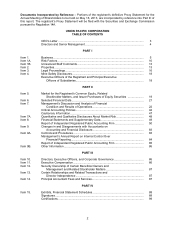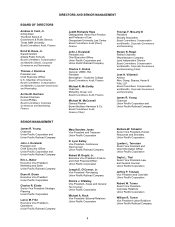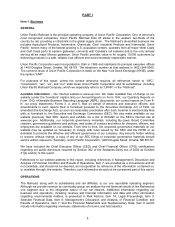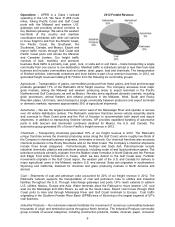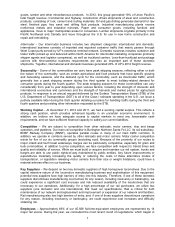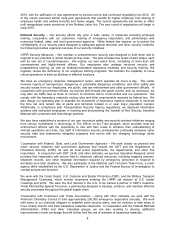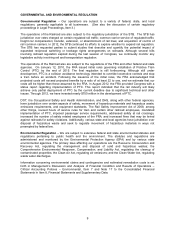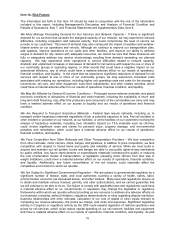Union Pacific 2012 Annual Report Download - page 8
Download and view the complete annual report
Please find page 8 of the 2012 Union Pacific annual report below. You can navigate through the pages in the report by either clicking on the pages listed below, or by using the keyword search tool below to find specific information within the annual report.8
2010, with the ratification of new agreements by several unions that continued negotiating into 2012. All
of the unions executed similar multi-year agreements that provide for higher employee cost sharing of
employee health and welfare benefits and higher wages. The current agreements will remain in effect
until renegotiated under provisions of the Railway Labor Act. The next round of negotiations will begin in
early 2015.
Railroad Security – Our security efforts rely upon a wide variety of measures including employee
training, cooperation with our customers, training of emergency responders, and partnerships with
numerous federal, state, and local government agencies. While federal law requires us to protect the
confidentiality of our security plans designed to safeguard against terrorism and other security incidents,
the following provides a general overview of our security initiatives.
UPRR Security Measures – We maintain a comprehensive security plan designed to both deter and to
respond to any potential or actual threats as they arise. The plan includes four levels of alert status, each
with its own set of countermeasures. We employ our own police force, consisting of more than 200
commissioned and highly-trained officers. Our employees also undergo recurrent security and
preparedness training, as well as federally-mandated hazardous materials and security training. We
regularly review the sufficiency of our employee training programs. We maintain the capability to move
critical operations to back-up facilities in different locations.
We have an emergency response management center, which operates 24 hours a day. The center
receives reports of emergencies, dangerous or potentially dangerous conditions, and other safety and
security issues from our employees, the public, and law enforcement and other government officials. In
cooperation with government officials, we monitor both threats and public events, and, as necessary, we
may alter rail traffic flow at times of concern to minimize risk to communities and our operations. We
comply with the hazardous materials routing rules and other requirements imposed by federal law. We
also design our operating plan to expedite the movement of hazardous material shipments to minimize
the time rail cars remain idle at yards and terminals located in or near major population centers.
Additionally, in compliance with Transportation Security Agency regulations, we deployed information
systems and instructed employees in tracking and documenting the handoff of Rail Security Sensitive
Material with customers and interchange partners.
We also have established a number of our own innovative safety and security-oriented initiatives ranging
from various investments in technology to The Officer on the Train program, which provides local law
enforcement officers with the opportunity to ride with train crews to enhance their understanding of
railroad operations and risks. Our staff of information security professionals continually assesses cyber
security risks and implements mitigation programs that evolve with the changing technology threat
environment.
Cooperation with Federal, State, and Local Government Agencies – We work closely on physical and
cyber security initiatives with government agencies that include the DOT and the Department of
Homeland Security (DHS), as well as local police departments, fire departments, and other first
responders. In conjunction with DOT, DHS, and other railroads, we sponsor Operation Respond, which
provides first responders with secure links to electronic railroad resources, including mapping systems,
shipment records, and other essential information required by emergency personnel to respond to
accidents and other situations. We also participate in the National Joint Terrorism Task Force, a multi-
agency effort established by the U.S. Department of Justice and the Federal Bureau of Investigation to
combat and prevent terrorism.
We work with the Coast Guard, U.S. Customs and Border Protection (CBP), and the Military Transport
Management Command, which monitor shipments entering the UPRR rail network at U.S. border
crossings and ports. We were the first railroad in the U.S. to be named a partner in CBP’s Customs-
Trade Partnership Against Terrorism, a partnership designed to develop, enhance, and maintain effective
security processes throughout the global supply chain.
Cooperation with Customers and Trade Associations – Along with other railroads, we work with the
American Chemistry Council to train approximately 200,000 emergency responders annually. We work
with many of our chemical shippers to establish plant security plans, and we continue to take steps to
more closely monitor and track hazardous materials shipments. In cooperation with the Federal Railroad
Administration (FRA) and other interested groups, we are also working to develop additional
improvements to tank car design that will further limit the risk of releases of hazardous materials.


